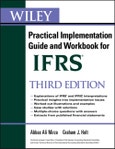A one-stop resource for understanding and applying current International Financial Reporting Standards
As the International Accounting Standards Board (IASB) makes rapid progress towards widespread acceptance and use of IFRS® (formerly named International Accounting Standards) worldwide, the need to understand these new standards increases. Now fully revised and updated, IFRS® Practical Implementation Guide and Workbook, Third Edition is the straightforward handbook for understanding and adapting the IFRS® standards.
This quick reference guide includes easy-to-understand IAS/IFRS®outlines, explanations, and practical insights that greatly facilitate understanding of the practical implementation issues involved in applying these complex standards.
Clearly explaining the IASB standards so that even first-time adopters of IFRS® will understand the complicated requirements, the Third Edition presents:
- Ten recently issued and revised IFRS® standards including business combinations, financial instruments and newly issued IFRS® for SMEs
- New International Financial Reporting Interpretations Committee (IFRIC) projects
- Multiple-choice questions with solutions and explanations to ensure thorough understanding of the complex IFRS®/IAS standards
- Case studies or "problems" with solutions illustrating the practical application of IFRS®/IAS
- Excerpts from published financial statements around the world
Designed with the needs of the user in mind, IFRS® Practical Implementation Guide and Workbook, Third Edition is an essential desktop reference for accountants and finance professionals, as well as a thorough review guide for the IFRS®/IAS certification exam.
Table of Contents
Preface xi
Acknowledgements xiii
About the Authors xv
1 Introduction to International Financial Reporting Standards 1
2 IASB Framework 11
3 Presentation of Financial Statements (IAS 1) 17
4 Inventories (IAS 2) 31
5 Statement of Cash Flows (IAS 7) 41
6 Accounting Policies, Changes in Accounting Estimates and Errors (IAS 8) 59
7 Events After the Reporting Period (IAS 10) 73
8 Construction Contracts (IAS 11) 81
9 Income Taxes (IAS 12) 93
10 Property, Plant, and Equipment (IAS 16) 113
11 Leases (IAS 17) 123
12 Revenue (IAS 18) 139
13 Employee Benefits (IAS 19) 155
14 Accounting for Government Grants and Disclosure of Government Assistance (IAS 20) 171
15 The Effects of Changes in Foreign Exchange Rates (IAS 21) 179
16 Borrowing Costs (IAS 23) 191
17 Related-Party Disclosures (IAS 24) 199
18 Accounting and Reporting by Retirement Benefit Plans (IAS 26) 213
19 Consolidated and Separate Financial Statements (IAS 27) 221
20 Investments in Associates (IAS 28) 233
21 Financial Reporting in Hyperinflationary Economies (IAS 29) 245
22 Interests in Joint Ventures (IAS 31) 251
23 Financial Instruments: Presentation (IAS 32) 263
24 Financial Instruments: Recognition and Measurement (IAS 39) 287
25 Earnings Per Share (IAS 33) 339
26 Interim Financial Reporting (IAS 34) 355
27 Impairment of Assets (IAS 36) 363
28 Provisions, Contingent Liabilities, and Contingent Assets (IAS 37) 379
29 Intangible Assets (IAS 38) 393
30 Investment Property (IAS 40) 407
31 Agriculture (IAS 41) 415
32 First-Time Adoption of International Financial Reporting Standards (IFRS 1) 425
33 Share-Based Payments (IFRS 2) 445
34 Business Combinations (IFRS 3) 463
35 Insurance Contracts (IFRS 4) 483
36 Noncurrent Assets Held for Sale and Discontinued Operations (IFRS 5) 491
37 Exploration for and Evaluation of Mineral Resources (IFRS 6) 503
38 Financial Instruments: Disclosures (IFRS 7) 511
39 Operating Segments (IFRS 8) 531
40 Financial Instruments (IFRS 9) 537
41 IFRS for SMEs 551
Answers for Multiple-Choice Questions 567
Index 571








